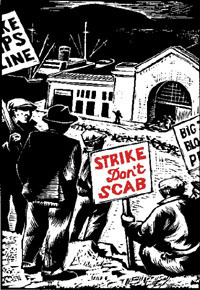|
|
|
|
|
|
West Coast Ports Set to Keep Humming With Cargo Volumes Slumping, Expiring Contract Unlikely to Trigger Labor Discord
West Coast Ports Set to Keep Humming
With Cargo Volumes Slumping, Expiring Contract Unlikely to Trigger Labor Discord
http://online.wsj.com/articles/west-coast-ports-set-to-keep-humming-1404...
By JOEL MILLMAN CONNECT
June 29, 2014 7:47 p.m. ET
A worker at the Port of Seattle, which has spent almost $350 million since 1999 to upgrade its docks and road and rail connections. Amanda Koster for The Wall Street Journal
SEATTLE—West Coast ports have seen wildcat strikes and human blockades of railroad tracks in recent years as militant union members accused terminal operators of allegedly flouting the terms of labor contracts.
Now, against a backdrop of a tighter, tougher port economy, something new appears to be stirring: labor peace.
With the contract set to expire at 12:01 a.m. Tuesday between the International Longshore and Warehouse Union, which represents dockworkers, and the Pacific Maritime Association, representing port employers, it's expected the two sides will eventually reach an agreement without a labor disruption.
Negotiations between the two sides began last month in San Francisco. Instead of the sniping that often has accompanied bargaining that affects about 20,000 port workers from Seattle to San Diego, labor and management opened the talks in conciliatory tones.
"Dockworkers are looking forward to negotiating a fair agreement that protects the good jobs and benefits that support thousands of families and dozens of communities around West Coast ports," ILWU President Bob McEllrath said in a statement before the union suspended further comment during the talks.
Past years were acrimonious. In 2002, bargaining broke down as ILWU workers charged that port employers had locked them out. A work stoppage ended only after President George W. Bush invoked the seldom-used Taft-Hartley Act, forcing dock operations to resume.
Much has changed for West Coast ports since then as they fight over a shrinking market. Total imports arriving in containers fell to 60.6 million metric tons last year from 65.5 million in 2004. Fewer vessels mean less demand for dock workers.
The coast's share of containerized cargo fell from just over half of all tonnage arriving from Asia in 2004 to about 40% in 2013, much of that erosion coming from increased competition from Canada and Mexico. That has contributed to the air of harmony between port operators and dockworkers.
"Labor definitely has become easier to work with," said Michael Patalano, general manager of SSA Terminals in Seattle, as he supervised unloading of containers from a French vessel recently.
ILWU spokesman Craig Merrilees said the total number of hours worked by all of the union's West Coast members dropped to less than 30 million last year from nearly 35 million during the peak year of 2006.
The average wage for stevedores on the West Coast topped $40 an hour during that time, including various "skill" rates that raise some workers' pay, he added. Under the contract about to expire, base wages start at $35.68, up from $28.18 in 2003, an increase that the ILWU says barely matched inflation. Nor have wages kept pace with productivity gains, the union says.
Trans-Pacific imports—the value of all Asian goods entering West Coast ports—total about $450 billion annually, according to data compiled by U.S. Customs. Handling that cargo supports nearly 130,000 direct jobs at ports in Washington, Oregon and California, according to industry expert John Martin, who prepared an economic analysis of port issues before collective bargaining talks.
Mr. Martin said that translates into more than $30 billion in business for the shipping, warehousing, trucking and forwarding companies clustered around ports like Seattle's.
But with cargo traffic down, West Coast operators are fighting to maintain volume by underbidding each other to keep ships calling in a high-stakes game, whose score is tallied by the number of cargo containers port cranes move from ships' holds onto railcars and truck trailers. Seattle's container volume dropped to 1.6 million units last year, down 35% since 2010.
Port officials say the market means shippers can dictate terms. "They're like sports teams threatening to leave if you don't build them a new stadium," said John Creighton, a Seattle port official.
To stay competitive, the port has spent almost $350 million since 1999 to make its docks more efficient and road and rail connections speedier.
Still, some carriers have taken their business elsewhere. In 2012, the consortium known as shipping's Grand Alliance—Germany's Hapag-Lloyd, Japan's NYK and Hong Kong's OOCL—left Seattle for Tacoma, Wash., effectively shifting 20% of Seattle's container intake to its competitor 30 miles south.
The Port of Portland, Ore., cut similar deals with the South Korean carrier Hanjin Line, the latest this spring when it agreed to subsidies of $20 to $45 per container to keep Hanjin calling. That move capped a number of concessions Portland has made since 2012, which grew to $2.7 million through February, and could now rise to $4 million through the end of this year.
One of Hanjin's complaints: bickering between ILWU dockworkers and the local terminal operator had cut labor productivity—something union leaders dispute.
Shippers say they aren't being ruthless, simply passing on pricing demands from their customers: "big box" retailers and, ultimately, U.S. consumers.
"There are cost pressures on the entire supply chain; ocean carriers are no different," said Mike Moore of the Pacific Merchant Shipping Association, which represents vessel owners, pilots and terminals. "Carriers invested in newer and bigger ships just as cargo volumes declined," Mr. Moore added. "Now a lot of them are losing money, too."
Write to Joel Millman at joel.millman@wsj.com
-

- Log in to post comments
- Printer-friendly version



